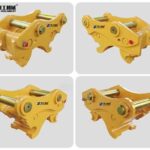Hydraulic plate compactor is a powerful tool designed to compact soil, gravel, sand, and other granular materials with high efficiency and precision. Utilizing hydraulic force, these compactors exert substantial pressure on the surface, ensuring optimal compaction for construction, landscaping, and infrastructure projects. Their versatility and effectiveness make them indispensable in various applications, from preparing foundations to maintaining roadways.
Features and Benefits of Vibratory Plate Compactor
- High Compaction Force
Hydraulic plate compactors generate significant force, enabling them to achieve superior compaction results in fewer passes compared to traditional methods. - Versatility
These compactors are suitable for a wide range of materials, including soil, gravel, sand, and crushed stone. They can be used in various applications, such as:
Foundation preparation for buildings and structures
Road and pavement construction
Landscaping and garden projects
Driveway and parking lot installations - Durability and Reliability
Constructed from high-quality materials, hydraulic plate compactors are built to withstand the rigors of heavy-duty use. Their robust design ensures long-term reliability and consistent performance.
Applications of the Plate Compactor for Excavators
Trench Compaction: Perfect for compacting backfill around pipes or utility lines without risking damage.
Slope Compaction: Ensures stability of embankments, hillsides, and retaining walls.
Road Construction: Prepares solid sub-bases for asphalt or concrete road paving.
Foundation Work: Compacts soil for retaining walls, poles, or structural bases.
Flood Control Projects: Strengthens dikes and levees through uniform compaction.
How to Select the Right Hydraulic Plate Compactor?
Choosing the right compactor depends on your excavator’s weight, the type of material to be compacted, and the job site’s working conditions. Consider the following:
Excavator Compatibility: Ensure the compactor matches your machine’s hydraulic flow and pressure.
Compaction Area: Larger plates for wide-open areas, smaller plates for narrow trenches.
Required Force: Higher centrifugal force for rocky or heavily compacted soil.


